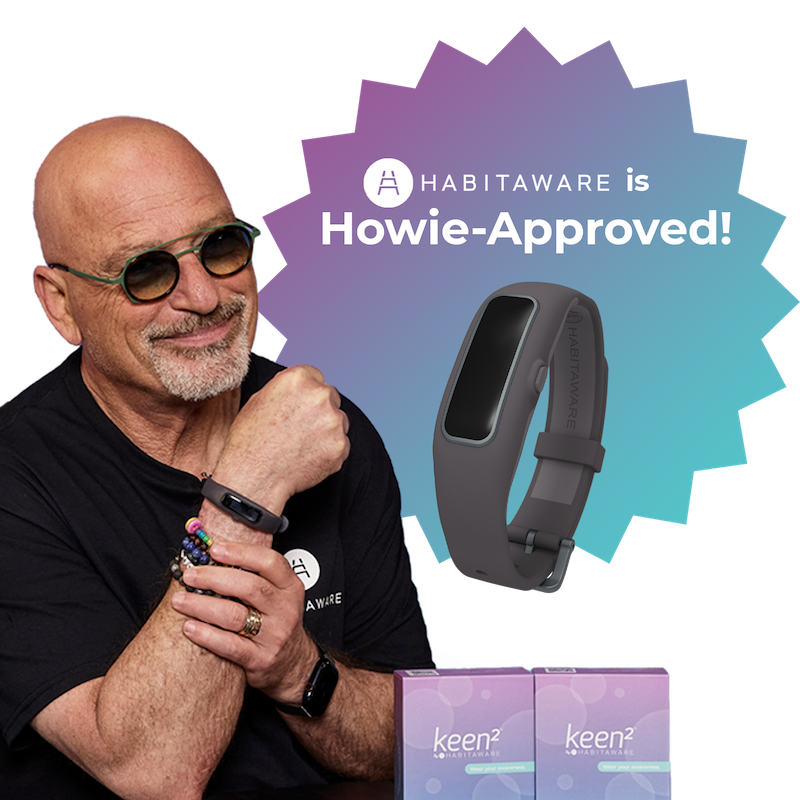38-year-old Adrienne lives in Michigan and has had Trichotillomania for 25 years. This is how she’s Conquering with Keen Awareness, in her own words.

From “Best Hair” to Hair Pulling Disorder
My hair was my “thing.” The thing I was known for. The thing that put a quiet, introverted, awkward girl in the yearbook for “Best Hair” right next to the popular girls. But, it was considered “big” hair – curly and frizzy to all the quintessential “mean girls” of middle school. So just before high school, I began to wish for simple, manageable, straight hair. I thought if I could just have less of the thick coarse hairs, all of my hair would be better. That was the start of my Trichotillomania.
I grew up in the early 90s, just before the earliest days of home internet, when a person’s social life was 95% in person and 5% on the phone. Social media, chat rooms, and online support groups didn’t exist. As a result, I was utterly alone with my hair pulling. For the first ten years of my hair pulling I didn’t know other people did what I did. I didn’t know there was a medical word for hair pulling: “Trichotillomania.” I thought I was weird, I thought I was gross, and at times I thought I was cursed.
My hair pulling focused on eliminating the coarse hairs eventually graduated to automatic pulling that I didn’t realize I was doing until the hair was gone from my head. I was convinced there was something morally and spiritually wrong with me. My mom did what she thought was best. She went about silently vacuuming the piles of long blonde hair off the floor, occasionally asking me if I wanted to see a therapist. She even got me a kitten, so my hands would stay busy petting and playing with her. But as far as my mom and I knew, I was the only one in the world slowly making myself bald, strand by strand.
In my early 20s, something magical happened. I stopped pulling my hair almost completely. I wasn’t trying to stop any more than I always had. But, I stopped enough to regrow my long, blonde ringlets. I experienced college life with hair, and it was glorious! I loved having hair. My Trichotillomania gradually returned, but I was able to limit the hair pulling and hide it for 6-7 more years.
Living with Trichotillomania
Two pregnancies in 3 years plus all the accompanying hormones, followed by the demise of my relationship with my children’s father took a huge toll on my hair. My curls had all but disappeared as a consequence of pulling the thick curly hairs and leaving the thin, fine, straight ones behind. Every day, I spent over an hour in the mirror trying to get my ponytail just right so the bald spots were hidden. I would tell myself, “STOP, just STOP, STOP already!” only to find my hand in my hair a few seconds later. I was completely out of control.
Trichotillomania, like any Body Focused Repetitive Behavior (BFRB), is incredibly pervasive. It worked its way into every part of my life. I hated leaving the house because I was always self-conscious about my hair. I was going to work, paying bills, trucking two tiny humans back and forth to school and daycare, and raising them to be kind, honest, and loving. However, because my hair never looked “put together,” I never felt like my life was “put together.” My kids never had playdates because I hated being around other parents whose very proximity to me reminded me that my life still felt like a wreck. My career suffered. I put up with a job that was beneath my skill level working for a boss who loved to humiliate me. But, I didn’t feel like I could present myself as a candidate for a better job the way I looked. I rarely dated for similar reasons.
Even when I seemed to be winning my battle with Trichotillomania, I could never go a day, let alone an hour, without thinking about it. I was constantly cleaning up hair, and it wound up in the most awkward places. I would obsessively check files of paperwork before I handed them to coworkers, afraid a tiny curly hair would be stuck inside one. My kids would pick up their toys, which would be covered in my discarded hair. Cold and windy days instantly made me aware of my thinning spots. And forget about swimming in the summer – getting my hair wet in public was not going to happen.
Finding Trichotillomania Support
I finally found the Trichotillomania social media support groups that were filled with ideas on how to stop hair pulling: amino acids, beanies, and castor oil. I made up my mind to do everything, try everything, exhaust every resource within my means to bring my Trichotillomania under control. It took a few weeks for me to have a pull-free day, but I did it! Followed by another and another. But, I was “white knuckling” it. I couldn’t let my mind drift away from the constant repetition of, “Don’t pull, just don’t pull, DON’T PULL!” The minute I tried to focus on anything else, my hands were back in my hair. It was incredibly stressful and exhausting. I felt like I was a tiny hair that was being stretched almost to the point of snapping. I decided I needed more help.

The social media groups also talked about the habit tracking bracelet that alerts you when you are about to pull your hair. Since all my hair pulling in the last 20 years had been subconscious or “automatic,” I thought I was an excellent candidate for the Keen habit-awareness bracelet. Once I had my two Keens trained, I felt I was finally able to relax knowing that I would be alerted before I pulled my hair. I finally felt like myself again. That feeling alone was so worth it!
< See what others are saying about “Keen” Awareness >
Supporting others on their Trichotillomania Journey
I recently started a Facebook group called ‘Curl Trichs’ for people suffering from trichotillomania who have curly, wavy, or otherwise textured hair. I started this group because I was looking for something like it and it didn’t exist. There are Curl groups and trichotillomania support groups, and there are overlap in members. But there was no group specifically for curly-haired trichsters, and I thought there should be.
Curly or textured hair complicates trichotillomania and trichotillomania recovery in many ways. Many people with the disorder look for coarse, kinked hair to pull, and many of us curly-trichsters, find that ALL our hair is coarse or kinked. Disguising our spots is more difficult than our straight-haired trichster friends. Blending regrowth isn’t as simple as flat-ironing it (unless we want to spend hours flat-ironing the rest of our hair). Finding hair pieces to match one’s curl pattern and color is nearly impossible.
Curl patterns, coarse hair…curly hair is deeper than these textures. I’ve talked to so many curly-haired trichsters who grew up hating their hair, even before they started hair pulling. Maybe their mother didn’t know how to care for curls, maybe the person was teased or taunted about their hair. These things can resonate through a lifetime, and trichotillomania is generally a lifelong disorder (but trichotillomania recovery is possible!) Embracing and cultivating my curls with natural products and techniques specifically designed to help curly hair has changed my attitude about my hair and helped my trichotillomania recovery tremendously. So, I wanted to have a place for curly/wavy/kinked/textured haired trichsters to trade tips, DIY recipes, product info, but also to vent, celebrate each others victories and to provide support to one and other. That is my hope for the group. It’s a closed group but for the meantime it is searchable. If anyone is looking to join, you can search ‘Curl Trichs’ on Facebook or just click here!
Retrain Your Brain with HabitAware, the Trichotillomania Awareness Bracelet
I wanted to make the most out of my investment in Keen. I decided to “retrain my brain” as HabitAware suggests. Keen is an amazing tool, but tools need to be utilized to do this extraordinary thing. Just like an alarm clock doesn’t force me to get out of bed and go to work; the keen vibration alone wouldn’t retrain my brain. I began taking the advice from the HabitAware blog and other sites regarding Cognitive Behavioral Therapy. I wanted to replace my behavior with a healthier choice.
< Join Adrienne and thousands of others by picking up your own Keen today! >
“

Keen is my self-care “alarm.”
” — Adrienne
If my Keens start vibrating, I take a deep breath and drink a sip of ice water. If my Keens keep vibrating, I adjust my posture and do more breathing exercises. If my Keens still keep vibrating, I get up and walk somewhere, even if it’s just to the restroom to wash my hands or put cold water on my face. The vibration alerts me that I’m about to pull my hair, and I respond by relaxing my body and mind. Keen’s vibration is a hair pulling alarm… but it’s also a “self-care” alarm.
I can’t pinpoint exactly when it happened, but something inside me changed. Subtle physiological, emotional, and mental changes precede pulling. Stress and anxiety start to build, but it happens so subtly, it is easy to ignore. I began recognizing all the little micro changes BEFORE my anxiety bubbled over and before my Keens vibrate. Those feelings are now my “alarm,” letting me know it’s time to decompress before I reach the point of searching for a hair to pull. I use breathing, yoga, exercise, music – whatever it takes to eliminate the stress and anxiety. Just like Trichotillomania can permeate all areas of a Trichster’s life, substituting positive behaviors for destructive ones will resonate in other sectors of life. This type of self-care required for this process is so beneficial to physical, mental and spiritual health.
“I feel more comfortable, so I’m a better role model.” — Adrienne
Since I started using Keen, my hair has completely filled in. I know it’s just hair and it shouldn’t matter. But I love that I don’t feel cold breezes on my thin spots anymore. As soon as I quit hair pulling, I stopped finding stray hairs on everything. (It’s taking much longer to break the habit of obsessively checking paperwork before handing it off to coworkers – but I haven’t seen a stray hair in a file or on a stack of papers since!) More importantly, I’m calmer and generally just more relaxed. I feel comfortable talking to other parents, so my kids’ lives have gotten so much better.
Plus, I’m more confident and that alone makes me feel like I’m a better role model. Last month I swam in a hotel pool with my kids and I was 100% comfortable. For the first time in a decade, I even went to the salon for highlights to celebrate 7 months of Trichotillomania recovery!
I would absolutely recommend the Keen habit tracking bracelets to anyone with a BFRB, such as hair pulling, skin picking, or nail biting. Keen by itself is a great tool to alert a person before they pull their hair. And the support at Habitaware is exceedingly helpful during the entire process (and forever afterward too!).
But the real magic is in the process of replacing the behavior while retraining your brain and the healing that results when a person commits to it.
~Aneela and the Team


